new posts in all blogs
Viewing: Blog Posts Tagged with: black history month, Most Recent at Top [Help]
Results 26 - 50 of 135
How to use this Page
You are viewing the most recent posts tagged with the words: black history month in the JacketFlap blog reader. What is a tag? Think of a tag as a keyword or category label. Tags can both help you find posts on JacketFlap.com as well as provide an easy way for you to "remember" and classify posts for later recall. Try adding a tag yourself by clicking "Add a tag" below a post's header. Scroll down through the list of Recent Posts in the left column and click on a post title that sounds interesting. You can view all posts from a specific blog by clicking the Blog name in the right column, or you can click a 'More Posts from this Blog' link in any individual post.

By: Samantha McGinnis,
on 2/3/2015
Blog:
First Book
(
Login to Add to MyJacketFlap)
JacketFlap tags:
Book lists,
Books & Reading,
Black history month,
African-American history,
Bad News for Outlaws,
Laurie Halse Anderson,
Kathleen Krull,
Chains,
Maya Angelou,
Bryan Collier,
Doreen Rappaport,
Martin's Big Words,
I Know Why The Caged Bird Sings,
Vaunda Micheaux Nelson,
Wilma Unlimited,
Add a tag
February is Black History Month and to celebrate we’re sharing five of our favorite books that honor the history and legacy of African Americans.
If you work with kids in need, you can find these and other great titles to celebrate Black History Month on the First Book Marketplace.
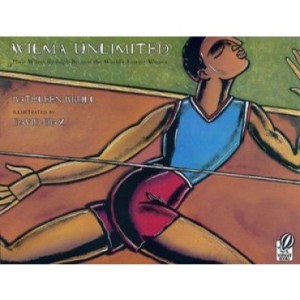 Wilma Unlimited: How Wilma Rudolph Became the World’s Fastest Woman by Kathleen Krull
Wilma Unlimited: How Wilma Rudolph Became the World’s Fastest Woman by Kathleen Krull
Before Wilma Rudolph was five years old, polio had paralyzed her left leg. Everyone said she would never walk again. But Wilma refused to believe it. Not only would she walk again, she vowed, she’d run. And she did run—all the way to the Olympics, where she became the first American woman to earn three gold medals in a single olympiad. This dramatic and inspiring true story is illustrated in bold watercolor and acrylic paintings by Caldecott Medal-winning artist David Diaz.
 Martin’s Big Words: The Life of Dr. Martin Luther King, Jr. by Doreen Rappaport and Bryan Collier
Martin’s Big Words: The Life of Dr. Martin Luther King, Jr. by Doreen Rappaport and Bryan Collier
This picture book biography of Dr. Martin Luther King, Jr. brings his life and the profound nature of his message to young children through his own words. Martin Luther King, Jr., was one of the most influential and gifted speakers of all time. Doreen Rappaport uses quotes from some of his most beloved speeches to tell the story of his life and his work in a simple, direct way. Bryan Collier’s stunning collage art combines remarkable watercolor paintings with vibrant patterns and textures.
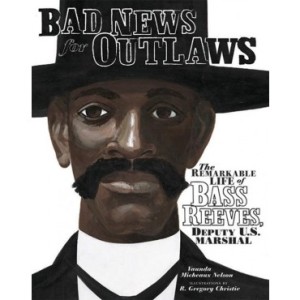 Bad News for Outlaws: The Remarkable Life of Bass Reeves, Deputy U. S. Marshal by Vaunda Micheaux Nelson
Bad News for Outlaws: The Remarkable Life of Bass Reeves, Deputy U. S. Marshal by Vaunda Micheaux Nelson
Sitting tall in the saddle, with a wide-brimmed black hat and twin Colt pistols on his belt, Bass Reeves seemed bigger than life. Outlaws feared him. Law-abiding citizens respected him. As a peace officer, he was cunning and fearless. When a lawbreaker heard Bass Reeves had his warrant, he knew it was the end of the trail, because Bass always got his man, dead or alive. Born into slavery in 1838, Bass had a hard and violent life, but he also had a strong sense of right and wrong that others admired. When Judge Isaac Parker tried to bring law and order to the lawless Indian Territories, he chose Bass to be a deputy U.S. Marshall. Bass would quickly prove a smart choice. The story of Bass Reeves is the story of a remarkable African American and a remarkable hero of the Old West.
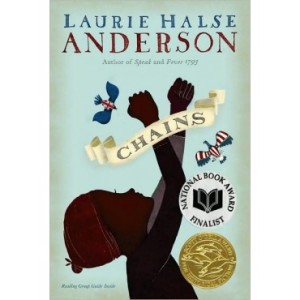 Chains by Laurie Halse Anderson
Chains by Laurie Halse Anderson
As the Revolutionary War begins, thirteen-year-old Isabel wages her own fight…for freedom. Promised freedom upon the death of their owner, she and her sister, Ruth, in a cruel twist of fate become the property of a malicious New York City couple, the Locktons, who have no sympathy for the American Revolution and even less for Ruth and Isabel. When Isabel meets Curzon, a slave with ties to the Patriots, he encourages her to spy on her owners, who know details of British plans for invasion. She is reluctant at first, but when the unthinkable happens to Ruth, Isabel realizes her loyalty is available to the bidder who can provide her with freedom.
 I Know Why The Caged Bird Sings by Maya Angelou
I Know Why The Caged Bird Sings by Maya Angelou
Sent by their mother to live with their devout, self-sufficient grandmother in a small Southern town, Maya and her brother, Bailey, endure the ache of abandonment and the prejudice of the local “powhitetrash.” At eight years old and back at her mother’s side in St. Louis, Maya is attacked by a man many times her age–and has to live with the consequences for a lifetime. Years later, in San Francisco, Maya learns about love for herself and the kindness of others, her own strong spirit, and the ideas of great authors (“I met and fell in love with William Shakespeare”) will allow her to be free instead of imprisoned.
*Book descriptions shown are publisher descriptions and have not been written by First Book.
The post 5 Books to Celebrate Black History Month appeared first on First Book Blog.

The Magic Mirror by Zetta Elliott. Illustrations by Paul Melecky. Rosetta Press, 2014. Review copy. Kamara suffers from the mean words of a boy at school until her Gramma comforts her and shows her the ancient mirror kept in a back bedroom of her old house. Kamara willingly cleans Gramma's mirror and discovers a magical storytelling window into her own family history. Generations of brave,
By: David D Bernstein,
on 3/20/2014
Blog:
Children's Books, and Other Cool Stuff
(
Login to Add to MyJacketFlap)
JacketFlap tags:
children,
adventure,
classics,
picture books,
dogs,
animals,
Black History month,
action,
engines,
new books.,
Add a tag
Picture Books
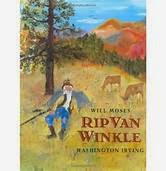 Rip Van Winkle
Rip Van Winkle- Retold and illustrated by Will Moses, based on Washington Irving's book. Philomel Books a division of Penguin Putnam Books for young readers. New York 1999. This book is based on a classical folk tale about a man who goes into the woods and falls asleep waking up many years later to a new world. This classic tale is retold with a combination of wonderful illustrations and words. It is probably better suited for the older child because of complex words and storyline. This new version brings a wonderful story back to our modern world. The storyline and sophisticated crafted words make it more suited for an older child.
- Written by Patricia Reilly Giff and illustrated by Laura J. Bryant. Published by Orchard books New York an imprint of Scholastic Inc. 2014. The book describes one day in a life of a little girl named Patti and her home companions mainly a dog named Tootsie and a new doll she got. With an imaginative approach, the author turns an regular day into an adventure and makes the ordinary into the extraordinary. A good book for you to get for you kids.
The Fisherman & His Wife- Based on a story by Grimm and Illustrated by John Howe 1984. Published by Creative Editions Mankato MN, 2001. The fisherman is happy living a simple life until one day everything turns around when he catches a magical fish. The fisherman's wife cannot be satisfied with what she gets. Her greed takes away everything the fish gave them. It is a great book for the older reader and the illustrations are stunning.
Trouper- Written by Meg Kearney and Illustrated by E.B. Lewis. Published by Scholastic Inc. NY, 2013. The book is written from the point of view of a dog. The dog Trouper tells us his life story: how he lived on the streets t the time he was put in a pound and finally adopted. This book makes readers empathize with millions of abandoned dogs running on the streets or sitting in cages in the pounds waiting to find a loving home. I highly recommend this book to everyone.
 The Little Engine that Could
The Little Engine that Could- Retold by Watty Piper and New Art by Loren Long. Published by Philomel Books a Division of Penguin Young Readers Group 2005. This is a great version of a classic. I loved how the writer and illustrator gave life to the characters. The story does not only teach children a lesson about never giving up, but it also introduces them to four kind of trains. I really loved this book and I strongly recommend you get it with your children. Each of us can accomplish anything we put our mind too.
 Under the Same Sun
Under the Same Sun- Written by Sharon Robinson and Illustrated by AG Ford. Published by Scholastic Press, New York 2014. This is a great educational book about Tanzania a small country in Africa. One can vividly imagine the beautiful land of Africa with its lush scenery and many different animals. This book is very unique and the illustrations are amazing. The story is idle for a classroom setting.

 As February comes to an end, we round out Black History Month with a guest post by Pamela M.Tuck, author of As Fast As Words Could Fly. We asked her if there was one person she could choose to be as well-known or remembered as Rosa Parks, who would it be and why?
As February comes to an end, we round out Black History Month with a guest post by Pamela M.Tuck, author of As Fast As Words Could Fly. We asked her if there was one person she could choose to be as well-known or remembered as Rosa Parks, who would it be and why?
In a segregated all-black school, a young student was empowered by an African American motivational speaker from Washington, DC. It was 1960s North Carolina and this speaker, in the student’s mind, was famous. The young student was my mother, Pauline Teel, and the speaker was Cortez Peters.
Cortez Peters, Sr. taught himself to type, at the age of 11, on a used typewriter his father had received in a trade. His “hunt and peck” system later developed into a fast and accurate method that garnered him the title of World Typing Champion, with speeds over 100 words per minute. He was the founder of the Cortez W. Peters Business School, which debuted in 1934. It was one of the first vocational schools in Washington, DC to prepare African Americans for business and civil services. The opening of his school became a pivotal point in history for African Americans.
 Cortez Peters, Jr. began typing at the age of 12. He eventually surpassed his father’s world record with a typing speed of 225 words per minute with no mistakes.
Cortez Peters, Jr. began typing at the age of 12. He eventually surpassed his father’s world record with a typing speed of 225 words per minute with no mistakes.
Both Peters Sr. and Peters Jr. made a career out of teaching their craft to others.
At that unforgettable school visit, Cortez Peters awed my mother and the other students with his rhythmic typing finesse. My mother remembers how his typing mimicked the tunes of many songs, and how he made artistic configurations on his paper. She stated, “He would use all A’s to form the letter A, and all B’s to form the letter B.” His phenomenal typing ability was an amazing entertainment for the students, but his accomplishments as an African American entrepreneur made him an empowering role model.
Cortez gave his formula of success to the students in 3 simple words: Determination, Inspiration, and Perspiration. Determined not to let anyone or anything stop them from reaching their dreams. Inspired to do whatever it takes to accomplish their dreams. And work hard (Perspiration) to make those dreams come true.
Cortez Peters’ formula for success became ingrained into my mother and was one of the driving forces that helped shape her into the successful woman she became. Enough so, that she passed the formula on to me and I have passed it on to my children.
With the impression Cortez Peters made on my mom, I guess it seems fitting that her high school sweetheart, my dad, turned out to be a local typing champion. Ironically, Cortez Peters and my dad unknowingly shared the same formula for success, and As Fast As their Words Could Fly, change was taking place, history was being made, and dreams were coming true.
Filed under:
guest blogger,
Musings & Ponderings Tagged:
Black History,
black history month,
cortez peters,
Pamela Tuck,
Rosa Parks,
typing 


By: Alice,
on 2/28/2014
Blog:
OUPblog
(
Login to Add to MyJacketFlap)
JacketFlap tags:
explorer,
infographic,
African Americans,
novices,
Social Sciences,
*Featured,
Images & Slideshows,
social explorer,
demography,
Online products,
employment rates,
household ownership,
per capita income,
demographic,
interface,
History,
interactive,
black history month,
Current Affairs,
Geography,
America,
census,
Add a tag
In celebration of Black History Month, Social Explorer has put together an interactive infographic with statistics from the most recent Census and American Community Survey. Dig into the data to find out about current African American household ownership, employment rates, per capita income, and more demographic information.
Take a sneak peak below and visit Social Explorer Presents Black History Month for the full, interactive infographic.

Social Explorer provides quick and easy access to current and historical census data and demographic information. The easy-to-use web interface lets users create maps and reports to illustrate, analyze, and understand demography and social change. In addition to its comprehensive data resources, Social Explorer offers features and tools to meet the needs of demography experts and novices alike. From research libraries to classrooms to government agencies to corporations to the front page of the New York Times, Social Explorer helps the public engage with society and science.
Subscribe to the OUPblog via email or RSS.
Subscribe to only social sciences articles on the OUPblog via email or RSS.
The post African American demography [infographic] appeared first on OUPblog.


By: AlyssaB,
on 2/27/2014
Blog:
OUPblog
(
Login to Add to MyJacketFlap)
JacketFlap tags:
caribbean,
africans,
Humanities,
*Featured,
plantations,
plantation,
African American Religion,
Caribbean Slavery,
noel erskine,
plantation church,
erskine,
Books,
History,
Africa,
Religion,
black history month,
slavery,
America,
african american,
Add a tag
In honor of Black History Month, we sat down with Noel Erskine to learn more about the Plantation Church—the religions that formed on plantations during slavery—and its roots in the Caribbean.
How was the Plantation Church formed?
The Plantation Church was formed through the traffic across the Black Atlantic of Africa’s children, packed like sardines, and treated as human cargo, to work on plantations in the Americas. The plantation was at first a site of human bondage, and provided the context for chattel slavery, where the entire family was brutalized as they realized that there was a connection between higher sugar prices and cruel treatment of slaves. In plantation society the political power of the African chief was transferred to the white master, except in the context of the plantation, there were no safeguards for women and children. The entire family was dehumanized. Plantation etiquette required submission to the wishes of the master and failure to comply would often elicit a violent response. The will of the master applied to every aspect of plantation life. The master had the right to whip, sell, or trade members of the family whenever or for whatever reason. Africans found it difficult at first to mount a credible form of resistance against the violence perpetrated against them on plantations.
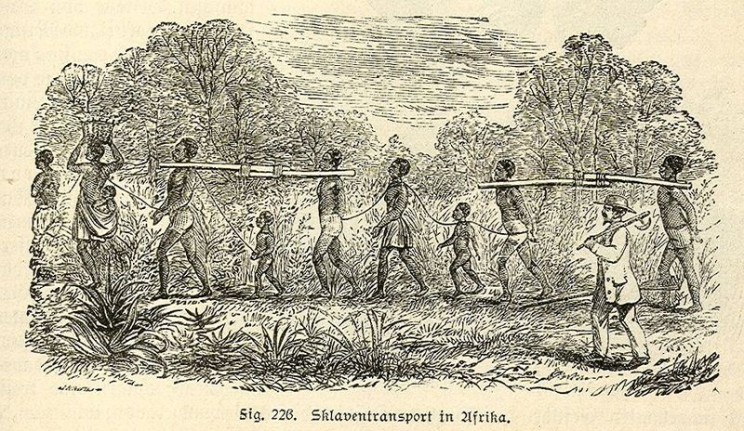
Slaves being transported in Africa, 19th century engraving. From Lehrbuch der Weltgeschichte oder Die Geschichte der Menschheit by William Rednbacher, 1890. Public domain via Wikimedia Commons.
Why was the Plantation Church formed?
It is often forgotten that Africans who were captured and brought against their will to work on plantations in the New World left institutions of their clan and tribe behind. The creation of the Plantation Church was an attempt to hold body and soul together in an alien environment. In the Plantation Church, which was at first an African Church, Africans “stolen from the homeland” had to compensate for the loss of language, culture, and the constant change of environment as they were often sold and separated from members of their families. The cruelty meted out to Africans who traversed the Black Atlantic on route to the Caribbean and North American colonies for work in plantation society is beyond compare in the annals of the history of slavery. The Indians and Spaniards had the support and comfort of their families, their kinsfolk, their leaders, and their places of worship in their sufferings. Africans the most uprooted of all, were herded together like animals in a pen, always in a state of impotent rage, always filled with a longing for flight, freedom, change, and always having to adopt a defensive attitude of submission, pretense, and acculturation to the new world.
What characterized the Plantation Church?
Enslaved Africans on plantations “a long ways from home”, remembered home, and the memory of Africa became a controlling metaphor and organizing principle as they countered the hegemonic conditions imposed on them by their masters. There was a tension between their existence on plantations here in the New World and there in Africa, their home of origin. Here in plantation society they longed for there, their home, Africa – the forests, the ancestors, family, Gods and culture. They remembered the forests and they relived their experience of forests through the practice of religious rituals in the brush arbors, often down by the riverside. The memory of ancestors and a sense that their spirits accompanied them served as sites of a new consciousness on the plantations in which the struggle for survival and liberation took precedence. This awakening convinced them that they would survive through running away to the forests or through suicides that would reunite them with families and the Africa they remembered. It was primarily through religious rituals and the carving out of Black sacred spaces that enslaved persons were able to affirm self and create a world over against plantation society which was created for their families by the master. With the creation of the Plantation Church, the African priest and medicine man/woman were able to prevent the enslaved condition from dominating their consciousness and rob the children of Africa the freedom to dream a new world. It was the community’s memory of Africa that provided hope for dreaming the emergence of new worlds whether in Haiti, South Carolina, or Cuba.
Why is the Caribbean so important to the Plantation Church?
There were more than eleven million enslaved persons who were transported across the Black Atlantic and forced to work on plantations in the New World. Of this number, about 450, 000 arrived in the United States and all the rest went south of the border to the Caribbean nations and South America. More than twice the number of Africans who landed in the United States arrived in each of the islands of Haiti, Jamaica, and Cuba. Additionally, it must be noted that slavery began in the Caribbean as early as 1502, well over a hundred years before the first twenty Africans landed in James Town Virginia in 1619. The historical priority and the numerical advantage point to the Black religious experience being born in the Caribbean and not the United States of America. W.E.B. Du Bois puts this in perspective, “American Negroes, to a much larger extent than they realize, are not only blood relatives to the West Indians but under deep obligations to them for many things. For instance, without the Haitian Revolt, there would have been no emancipation in America as early as 1863. I, myself, am of West Indian descent and am proud of the fact.”
Noel Leo Erskine is Professor of Theology and Ethics at Candler School of Theology and the Laney Graduate School of Arts and Sciences at Emory University. He has been a visiting Professor in ten schools in six countries. His books include Plantation Church: How African American Religion Was Born in Caribbean Slavery, King Among the Thologians, and From Garvey to Marley.
Subscribe to the OUPblog via email or RSS.
Subscribe to only religion articles on the OUPblog via email or RSS.
The post The Plantation Church: a Q&A with Noel Erskine appeared first on OUPblog.


By:
keilinh,
on 2/28/2013
Blog:
The Open Book
(
Login to Add to MyJacketFlap)
JacketFlap tags:
biography,
nonfiction,
painting,
black history month,
slavery,
don tate,
overcoming obstacles,
Musings & Ponderings,
It Jes' Happened,
bill traylor,
dreams and aspirations,
African American interest,
united states history,
Add a tag
Everyone knows Frederick Douglass and Martin Luther King, Jr., but there are many other African Americans who have contributed to the rich fabric of our country but whose names have fallen through the cracks of history.
We’ve asked some of our authors who chose to write biographies of these talented leaders why we should remember them. We’ll feature their answers throughout Black History Month.
Today, Don Tate shares why he wrote about Bill Traylor in It Jes’ Happened: When Bill Traylor Started to Draw:
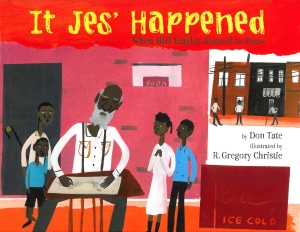
Bill Traylor was an “outsider artist.” He learned to draw in much the same way that I learned to paint: by trial and error. He taught himself to draw. Somehow I felt an immediate kinship to Bill. In his day, Bill’s art sold for about 10- to 25-cents and was panned by art critics as “primitive.” Today Bill’s art is collected by top art connoisseurs, and is on display in museums all over the world, selling for thousands of dollars. I love these kinds of stories where the “outsider” gets the glory.
Bill had an inborn – I believe God-given – talent that came forth in time of great need. That spoke to me, too. It supported my belief that all people are born equipped with everything needed to overcome great obstacles in life and do great things.

I think it’s important for children to be exposed to a variety of historical figures. Black history is not limited to the one or two people that are so often written and published about. In addition to civil rights, African Americans have made great contributions to science and technology, arts and literature, sports and entertainment, education and business. Bill Traylor was an artist, but he was also a journalist, though he may not have realized it. And a historian, too.Through his art, he documented an important part of American history that will be appreciated for many hundreds of years to come.
Further reading:
Black History Month: Why Remember Florence “Baby Flo” Mills?
Black History Month: Why Remember Robert Smalls?
Black History Month: Why Remember Toni Stone?
Black History Month: Why Remember Arthur Ashe?
Black History Month Book Giveaway
Filed under:
Musings & Ponderings Tagged:
African American interest,
bill traylor,
biography,
black history month,
don tate,
dreams and aspirations,
It Jes' Happened,
nonfiction,
overcoming obstacles,
painting,
slavery,
united states history 


By:
Hannah,
on 2/25/2013
Blog:
The Open Book
(
Login to Add to MyJacketFlap)
JacketFlap tags:
awards,
american library association,
black history month,
Resources,
guest blogger,
Why I Love Librarians,
African American history,
African/African American Interest,
coretta scott king awards,
Musings & Ponderings,
Publishing 101,
Add a tag
In this guest post, Dr. Henrietta M. Smith, Professor Emerita and the first African-American professor at the University of South Florida, School of Information shares her memories of how the Coretta Scott King Award began:
The news of the damage sustained by the boardwalk in Atlantic City during Hurricane Sandy brought back memories of where the Coretta Scott King Award started. This writer’s mind went back to an earlier time, to an American Library Association annual meeting in Atlantic City. 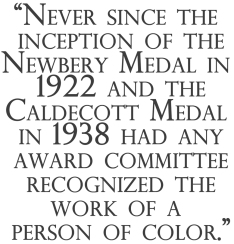 The year was 1969. Two librarians walking through the exhibit hall stopped by a booth where a poster of the late Martin Luther King Jr. was on display. This was the start of a genial conversation that evolved into the observation that never since the inception of the Newbery Medal in 1922 and the Caldecott Medal in 1938 had any award committee recognized the work of a person of color.
The year was 1969. Two librarians walking through the exhibit hall stopped by a booth where a poster of the late Martin Luther King Jr. was on display. This was the start of a genial conversation that evolved into the observation that never since the inception of the Newbery Medal in 1922 and the Caldecott Medal in 1938 had any award committee recognized the work of a person of color.
John Carroll, a publisher from a small company in New York, overheard the conversation. It was reported that he said, rather matter of factly, “Then why don’t you ladies establish your own award?” The seed was planted. Before the conference ended, in an informal meeting on the boardwalk in Atlantic City under the leadership of Glyndon Greer and Mabel McKissick, the idea of a award for African American authors was shared with a group of African American librarians, including Augusta Baker, Charlemae Rollins, Ella Mae Yates, and Virginia Lacy Jones, to name a few. At this seaside gathering, the struggle for recognition began.
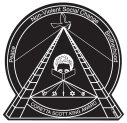 The ALA questioned the need for another award. A majority of publishers informed the committee that they did not have enough children’s books by African Americans to provide for evaluation. And many librarians were skeptical of anything becoming of this fragile brainchild. Undaunted and unconvinced that this venture was fruitless, the committee moved on. In 1970, the first Coretta Scott King Awards breakfast was scheduled in a hotel that just “happened” not to be on the ALA list of official hotels. After a meager meal and short program, the first recipient of the Coretta Scott King Award was announced. A school librarian from New Jersey, Lillie Patterson, went down in history as the first winner of the award for her elementary level biography, Martin Luther King, Jr.: Man of Peace.
The ALA questioned the need for another award. A majority of publishers informed the committee that they did not have enough children’s books by African Americans to provide for evaluation. And many librarians were skeptical of anything becoming of this fragile brainchild. Undaunted and unconvinced that this venture was fruitless, the committee moved on. In 1970, the first Coretta Scott King Awards breakfast was scheduled in a hotel that just “happened” not to be on the ALA list of official hotels. After a meager meal and short program, the first recipient of the Coretta Scott King Award was announced. A school librarian from New Jersey, Lillie Patterson, went down in history as the first winner of the award for her elementary level biography, Martin Luther King, Jr.: Man of Peace.

from Ray Charles
It was not until 1974 that the award breakfast was held in an ALA conference site, but even then, the CSK Award was not recognized as an official ALA award, nor was the award committee recognized as an official ALA body. But to the joy of all, publishers were now sending more quality books, and attendance at the 7:30 a.m. breakfast was steadily growing! Another change came in 1974 when the committee presented its first illustrator award. George Ford, who is still painting today, won for the illustrations he created for Sharon Bell Mathis’ biography Ray Charles.
In the years that followed, a major breakthrough came when E. J. Josey was elected president of the ALA. One of his first concerns was to bring the Coretta Scott King Committee into the official folds of the American Library Association. In 1980, the Coretta Scott King Committee became the Coretta Scott King Task Force, a viable part of Social Responsibilities Task Force (since 1993 a part of EMIERT), with founder Glyndon Greer as its first chair.
Growth and changes can be seen as the benchmark of this dynamic group of librarians. Artist Lev Mills designed the medal that is placed on each award-winning book. The symbols in the medal’s design each carry a special message; even the colors of the winner and honor book medals, and the more recent new talent award medal, have significance. The monetary prize for the winners was first given through the efforts of the late Basil O. Phillips of the Johnson Publishing Company, and today the encyclopedias from Britannica and World Book have moved from print into the digital age.
Following negotiations with the ALA parent body on Awards and Recognitions, and the late John Steptoe’s son, illustrator Javaka Steptoe, in 1995, the New Talent Award was established. It was named in honor of John Steptoe, whose first book, Stevie (1969), won national acclaim when the author/illustrator was only nineteen years of age.
With each meeting of the Coretta Scott King Task Force, new ideas for growth are on the docket. Among the newest is the Coretta Scott King/Virginia Hamilton Award for Lifetime Achievement, which goes to an African American author, illustrator, author/illustrator, or practitioner (such as a librarian) for his or her body of work or contributions to reading programs involving African American literature. Changes are constantly in the works too. New ideas for creating greater visibility and wider use of Coretta Scott King Award books and materials are a part of every Task Force meeting.
To think that all this started with a meeting on the boardwalk in Atlantic City! The very spot may not be there now, but surely the news reports about Hurricane Sandy conjured up many of these same memories for those who met on the boardwalk way back in 1969.
Dr. Henrietta M. Smith, native New Yorker, received her MLS degree from Columbia University and EdD from University of Miami, Florida. She teaches in the Materials for Youth in the School of Information (University of South Florida, Tampa, Florida). Longtime member of the ALA, Smith has served on Newbery Caldecott, Wilder (Chair), and Pura Belpré Award committees for ALSC and has chaired the Coretta Scott King Task Force and the CSK Award Committee. Smith received the ALSC Distinguished Service Award in 2008 and in 2011 was the first practitioner recipient of the Coretta Scott King/Virginia Hamilton Award for Lifetime Achievement in Librarianship.
Filed under:
guest blogger,
Musings & Ponderings,
Publishing 101,
Resources Tagged:
African American history,
African/African American Interest,
american library association,
awards,
black history month,
coretta scott king awards,
Why I Love Librarians 


By: Alice,
on 2/24/2013
Blog:
OUPblog
(
Login to Add to MyJacketFlap)
JacketFlap tags:
black history month,
woodson,
African American Studies,
african,
strived,
United States,
Abraham Lincoln,
leffler,
fredrick douglass,
American National Biography,
fredrick,
African Americans,
*Featured,
luncheon,
Online Products,
ANB,
African American lives,
Dr Carter Woodson,
abernathy,
attachment_35720,
History,
US,
Add a tag
February marks a month of remembrance for Black History in the United States. It is a time to reflect on the events that have enabled freedom and equality for African Americans, and a time to celebrate the achievements and contributions they have made to the nation.
Dr Carter Woodson, an advocate for black history studies, initially created “Negro History Week” between the birthdays of two great men who strived to influence the lives of African Americans: Fredrick Douglass and Abraham Lincoln. This celebration was then expanded to the month of February and became Black History Month. Find out more about important African American lives with our quiz.
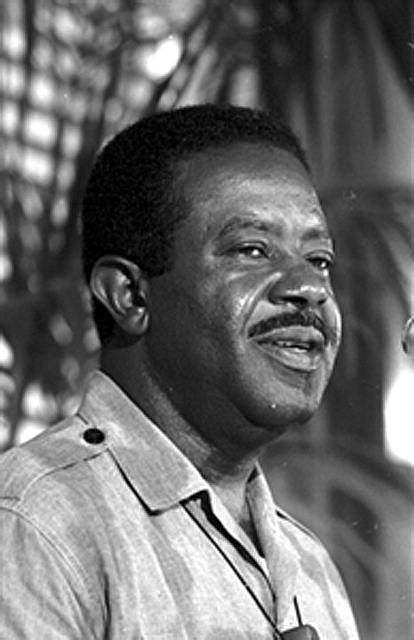
Rev. Ralph David Abernathy speaks at Nat’l. Press Club luncheon. Photo by Warren K. Leffler. 1968. Library of Congress.
Your Score:
Your Ranking:
The landmark American National Biography offers portraits of more than 18,700 men & women — from all eras and walks of life — whose lives have shaped the nation. The American National Biography is the first biographical resource of this scope to be published in more than sixty years.
Subscribe to the OUPblog via email or RSS.
Subscribe to only American history articles on the OUPblog via email or RSS.
The post African American lives appeared first on OUPblog.

By: David D Bernstein,
on 2/23/2013
Blog:
Children's Books, and Other Cool Stuff
(
Login to Add to MyJacketFlap)
JacketFlap tags:
picture books,
fantasy,
animals,
Black History month,
fireplace,
Children books,
discovering yourself,
winter.,
children,
family,
Great books,
illustrated,
love,
Add a tag
It has been a cold and snowy winter so far. I really hope that you take the time to purchase these picture books and share them with your young children by your fireplace. Please have fun and enjoy that special moment with them.
"I Want my Hat Back"- Written and Illustrated by Jon Klassen published by Candlewick
press 2011 Somerville, MA and a Theodor Seuss Geisel Honor book. A Bear's hat is stolen, but who has done it? He searches everywhere by talking to several of his animal friends. Have any of them seen it? This sounds like a simple concept for a story, but it is much more then that. What makes the book unique are the words and Illustrations. The hat is hidden in the story and your child has to find it. They have to look carefully. It can be used as a game for them, and this makes the book fun. Get a copy today.
"The Very Beary Tooth Fairy"- Written by Arthur A. Levine and Illustrated by Sarah S.Brannen, Published by Scholastic Press 2013 New York. All his life Zach the bear has been told to stay away from humans. Than one day he notices a family having a picnic and the little boy has a tooth loose. Zach discovers his tooth is also loose. What if the tooth fairy is a human, he has to find out for himself. The author's words and the illustrations give the legend of the tooth fairy a new twist. I really enjoyed this book very much. It is a great story to share with your kids. Get your youngster a copy, they will ask you to read over and over again.
"While Your Are Sleeping"- Written and Illustrated by Alexis Deacon, Published Farrar, Straus and Giroux New York 2006. What happens after the lights go out? This book explores this idea by creating a fantastic world where toys come to life to protect you. The words and illustrations blend perfectly together to make a great book that does not only teach your kids to take care of their toys, but to dream. It answers the question that every child has: "What happens when I sleep?" This delightful story for your young children to read at bedtime. I highly recommend this book for everyone.
"The Lamb and the Butterfly"- Written by Arnold Sundgaard and illustrated by Eric Carle, Published by Orchard Books an imprint of Scholastic Inc. New York 1988 reprinted 2013. Classic books stay with you all your life and inspire new generations as well. This book teaches a terrific lesson in a classic folk tale style. I was happy to see it re-released. It uses a combination of wonderful language and simple illustrations to show that every individual is unique, and so is their lifestyle. This book wisely teaches youngsters to identify with others, but to truly know themselves. This classic folk tale will be a great gift for your kids.
"Before You Came."- Written by Patricia Maclachlan and Emily Maclachlan Charest, Illustrated by David Diaz, Published by Katherine Tegan Books an imprint of Harper Collins Publishers New York 2011. Summary-"A mother relates how she spent time before her child arrived, then passes on a gift of days peddling a red canoe, reading in a pillow-filled hammock until dark, and watching the moon rise at night." The use of poetic language and beautiful illustrations explores a universal view of a bound between mother and child. I think that any parent can relate to it. Get a copy of this book and make your little one feel extra special.
"The Granddaughter Necklace."- Written by Sharon Dennis Wyeth and Illustrated by Bagram Ibatoulline, Published by Arthur A. Levine Books an imprint of Scholastic Inc.. January 2013.This picture book is a great read for Black History month. Summary- " A mother shares with her daughter stories of the generations of women in their family as each individual has passed along the tales and glittering necklace to her own daughter." I liked this book very much. I recommend it for older readers or to be used in a classroom setting. The illustrations are wonderful and the concept beyond the story is great.
Enjoy the picture books above, and I will have four new middle readers up in mid March.
by Charles R. Smith, Jr., illustrated by Floyd Cooper. HarperCollins, 2012 (F& G reader's proof) This lovely picture book (all I'm saying is Floyd Cooper, ladies and gentlemen...) tells the story of the building of the white house. In 1792 workers were needed to construct the White House. There weren't enough free labors so the government rented out the work of slaves from Virginia and Maryland

By:
keilinh,
on 2/21/2013
Blog:
The Open Book
(
Login to Add to MyJacketFlap)
JacketFlap tags:
black history month,
dancing,
performing,
African American history,
african american women,
florence mills,
African American interest,
baby flo,
dreams &,
Holidays,
inspiration,
Add a tag
Everyone knows Frederick Douglass and Martin Luther King, Jr., but there are many other African Americans who have contributed to the rich fabric of our country but whose names have fallen through the cracks of history.
We’ve asked some of our authors who chose to write biographies of these talented leaders why we should remember them. We’ll feature their answers throughout Black History Month.
Today, Alan Schroeder shares why he wrote about Florence Mills in Baby Flo: Florence Mills Lights Up the Stage:
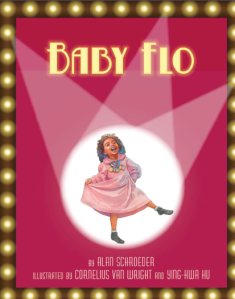
While researching African-American life, I have come across the name Florence Mills time and again. She was a famous singer and dancer in the 1920s, but not much is known about her today. She is a “forgotten” celebrity. Then, a few years ago, a man named Bill Egan wrote a marvelous biography of Mills, which I happened to read. Thanks to Mr. Egan, Mills’s incredible career sprang to life, and I knew I wanted to write about her — to share her story with young readers.
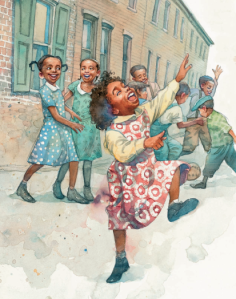
Unlike Booker T. Washington or Frederick Douglass or Martin Luther King, Jr., Florence Mills is not an important figure in American or African-American life. Children do not need to know about her in the way that they should know about Douglass or King, or Cesar Chavez, or Harvey Milk. Nevertheless, her story was interesting, and her hard work and many accomplishments can, I think, serve as an inspiration to young readers. In an amazingly short time, Florence Mills rose to the very top of her profession, and I had a wonderful time researching and writing about her.
Further reading:
Filed under:
Holidays Tagged:
African American history,
African American interest,
african american women,
baby flo,
black history month,
dancing,
dreams &,
florence mills,
inspiration,
performing 

I first heard about the Triple Nickles when I read the book
Jump into the Sky by Shelly Pearsall, the story of a young African American boy whose father was a paratrooper in 555th Parachute Infantry Battalion, or the Triple Nickles.
Now, Tanya Lee Stone's
Courage Has No Color tells the true story of the Triple Nickels, America's first and only all black unit of paratroopers in World War II. She begins their story by describing in graphic detail what it feels like to jump out of an airplane and parachute back to earth, to give you an idea of the level of courage it takes to be a paratrooper. It is not something I think I would want to ever do.
From there she writes about the kind of treatment black soldiers received in the military: segregated and relegated to service work and treated like servants. It was demeaning and demoralizing to the men who joined the military to fight for their country and freedom. One man, Walter Morris, a first sergeant in charge of Service Company of The Parachute School, saw how being treated like servants was affecting the men serving under him. Morris devised a plan to teach his men how to feel like soldiers again. It was his plan to teach them what they needed to know to become paratroopers. And so after the white serviceman were finished practicing for the day, and the black servicemen arrived to start cleaning up after them, they also began their training. And someone noticed how well they learned what was needed to become a successful paratrooper. Pretty soon, the First Lady Eleanor Roosevelt, long a proponent of equality, got into the act.
In 1941, The 99th Pursuit Squadron, or the Tuskegee Airmen, was formed and the men trained to be the country's first African American aviators. And in 1943, these airmen were finally sent into combat overseas. But the 555th Paratrooper Infantry Battalion was finally formed in February 1943. Though trained as paratroopers, the Triple Nickles would never be used in combat, instead they were sent to Oregon to fight fires. Turns out those fires were started by balloons sent over by Japan for that very purpose.
All of this and much more about the people and history of the 555th is detailed in
Courage Has No Color, including an in-depth explanation of how they got their name - yes, there more to it than just 555. It is a fascinating book covering this little known aspect of the United States military and World War II and an exceptional contribute to the history of African Americans in this country.
Stone has done an exemplary job of gathering primary source material, including interviews with some the of members of the 555th and lots of archival photographs, to bring to life the courage and heroism of these men and their accomplishments even against all odds. Included is a very eyeopening timeline of the desegregation and the Triple Nickles,
Sadly, the United States Military was not desegregated until 1950.
This book is recommended for readers age 10+
This book was obtained from the publisher
Oh yes, remember that description of jumping out of an airplane I mentioned, well, you too can experience what it is like to be a paratrooper by reading it
here.
A very useful teaching guide including Common Core connections, can be downloaded
here.

By: Alice,
on 2/21/2013
Blog:
OUPblog
(
Login to Add to MyJacketFlap)
JacketFlap tags:
black history month,
Jazz,
broadway,
NBC,
cole,
CBS,
Nat King Cole,
*Featured,
sponsorship,
Tuning In,
Arts & Leisure,
Tin Pan Alley,
American Television Music,
Ron Rodman,
African American musicians,
Dr. Billy Taylor,
Flip Wilson,
jazz pianist,
King Cole Trio,
Leslie Uggams,
mixed race performance,
musical variety show,
Nathanial Adams Coles,
race barrier,
Music,
Add a tag
By Ron Rodman
In this blog last month, I wrote about Dr. Billy Taylor and his pioneering work on television as an advocate for jazz. To celebrate Black History Month, it is appropriate to mention another African American musician who was a pioneer on American television: Nat King Cole, jazz pianist and vocalist, was the first African American musician to host a nationally-broadcast musical variety show in the history of television.

Publicity photo from the premiere of The Nat King Cole Show.
Nathanial Adams Coles was born in 1919 in Montgomery, Alabama. He first learned to play piano around the age of four with help from his mother, a church choir director, and by his early teens, was studying classical piano. He was drawn to the music of jazz pianist
Earl “Fatha” Hines, and eventually abandoned classical for jazz, which became his lifelong passion. At 15, he dropped out of school to become a jazz pianist full-time, and developed an act with his brother Eddie for a time, which led to his first professional recordings in 1936. He later joined a national tour for the musical revue
Shuffle Along, performing as a pianist.
In 1937, Cole started to put together what would become the “King Cole Trio,” the name being a play on the children’s nursery rhyme. As part of the trio, Cole expanded his own role in the group, both playing jazz piano and singing with his rich, velvety baritone voice. The trio toured extensively and finally landed on the charts in 1943 with Cole’s song, “That Ain’t Right.” His first big hit the following year was “Straighten Up and Fly Right,” a song reportedly inspired by one of his father’s sermons. The trio continued its rise to the top with such pop hits as the holiday classic “The Christmas Song” and the ballad “(I Love You) For Sentimental Reasons.”
By the 1950s, Nat King Cole emerged as a popular solo performer. He scored numerous hits, with such songs as “Nature Boy,” “Mona Lisa,” “Too Young, ” and “Unforgettable.” He worked with many of the greatest jazz artists in the country, like Louis Armstrong, Ella Fitzgerald, Frank Sinatra, arranger Nelson Riddle, and others.
However, the 1950s was a difficult decade for African American entertainers. In his performances around the country, Cole had encountered racism firsthand, especially while touring in the South. He had been attacked by white supremacists during a mixed race performance in Alabama. Yet, he was also criticized by other African Americans for his less-than-supportive comments about racial integration, and for performances for segregated audiences. Cole considered himself an entertainer and not an activist, and often sought to assimilate with white audiences.
1956 proved to be a pivotal year for Nat King Cole, and he was to become not just an entertainer, but also a pioneer for equal rights. By the mid-1950s, he had achieved status as a mainstream performer and sought to pursue this career as other stars had done — to produce and star in his own television show. His bid for a TV show brought with it a sense of mission. “It could be a turning point,” he realized, “so that Negroes may be featured regularly on television.” Cole realized the stakes were high, and said, “If I try to make a big thing out of being the first and stir up a lot of talk, it might work adversely.” Cole and his agents negotiated with CBS for a show, but his own program never materialized. Cole’s manager then tried NBC, and they successfully reached an agreement for The Nat “King” Cole Show.
The Nat “King” Cole Show debuted on 5 November 1956. The show aired without a sponsor, but NBC agreed to pay for initial production costs; the network assumed that once the show actually aired and advertisers were able to see its sophistication, a national sponsor would emerge. Cole exuded his benign, soft-spoken persona on the set, chatting with the TV audience and singing Broadway and Tin Pan Alley tunes. But the show was innovative in that it also featured Cole in his original role as a jazz pianist, playing and singing with jazz notables such as Oscar Peterson and Ella Fitzgerald. Cole also used his connections to bring other high caliber musicians to the show, many of whom voluntarily appeared with minimal compensation. Some of these included Harry Belafonte, Mel Tormé, Frankie Laine, and Peggy Lee (shown below).
Click here to view the embedded video.
Click here to view the embedded video.
Despite the high musical quality of the show, the race barrier seemed too much for the predominantly white TV audience of the 1950s to overcome. Many national companies balked at sponsorship, as they did not want to upset their white customers in the South who did not want to see a black man on TV shown in anything other than a subservient position. Although NBC agreed to fund the show until a sponsor could be found, Cole decided to cancel the show himself in its second season, disappointed with ratings and lack of sponsorship. Cole was quoted as saying of the doomed series, “Madison Avenue is afraid of the dark.” The last show was aired on 17 December 1957. After he cancelled his show, Nat King Cole continued to appear on other TV shows like The Ed Sullivan Show, The Garry Moore Show, and others.
Though short lived, The Nat “King” Cole Show paved the way for other black entertainers to find their way to television in the next decade. 1967 witnessed the premier of The Sammy Davis, Jr. Show on NBC, as a mid-season replacement that ran for 15 episodes.
Click here to view the embedded video.
In 1969, singer Leslie Uggams, hosted The Leslie Uggams Show, a musical comedy variety series that aired on CBS for one season in 1969.
Click here to view the embedded video.
Unfortunately, American audiences still seemed uncomfortable with TV shows hosted by sophisticated black musicians, and it finally took a comedian — Flip Wilson — to host a successful show, The Flip Wilson Show, which ran for four seasons on NBC from 1970-1974.
Ron Rodman is Dye Family Professor of Music at Carleton College in Northfield, Minnesota. He is the author of Tuning In: American Television Music, published by Oxford University Press in 2010. Read his previous blog posts on music and television.
Subscribe to the OUPblog via email or RSS.
Subscribe to only music articles on the OUPblog via email or RSS.
Image credit: Publicity photo from the premiere of The Nat King Cole Show. NBC Television. Via Wikimedia Commons.
The post The Nat “King” Cole Show: pioneer of music television appeared first on OUPblog.

I've been reading two great books on the Great Migration. Between 1915 and 1975 more than 6 million African Americans moved from Southern states to the North and West. Cities like Philadelphia, Washington D.C., New York, Cleveland, Detriot, Chicago, St. Lewis, San Diego and Los Angeles swelled in numbers of Black residents. This phenomena was bigger than the gold rush and the dust bowl as far as

By:
keilinh,
on 2/15/2013
Blog:
The Open Book
(
Login to Add to MyJacketFlap)
JacketFlap tags:
overcoming obstacles,
African/African American Interest,
Curriculum Corner,
Arthur Ashe,
dreams and aspirations,
Sports,
Tennis,
black history month,
discrimination,
Add a tag
Everyone knows Frederick Douglass and Martin Luther King, Jr., but there are many other African Americans who have contributed to the rich fabric of our country but whose names have fallen through the cracks of history.
We’ve asked some of our authors who chose to write biographies of these talented leaders why we should remember them. We’ll feature their answers throughout Black History Month.
Today, Crystal Hubbard shares why she wrote about Arthur Ashe in Game, Set, Match, Champion Arthur Ashe:
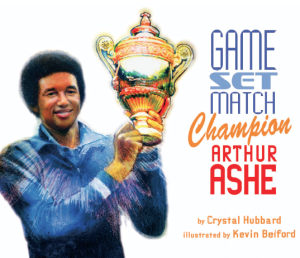
“Arthur Ashe is one of my heroes because he was a great athlete, but he was also a great human being. Tennis propelled him to fame, and he used his stature to bring attention to causes that people might otherwise have ignored. He used sports to help change the world for the better, not to get rich or gain popularity.
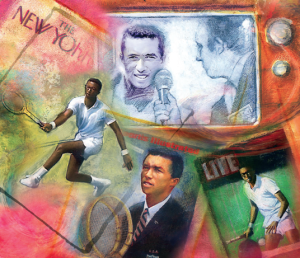
“I am most impressed by Mr. Ashe’s efforts to focus the world’s eyes on Apartheid. Through sports, he managed to bring attention to South Africa’s policy of racial segregation, and he was the first major sports figure to do so. Having grown up in segregated Richmond, Virginia, one would think that Mr. Ashe would have confronted Apartheid with anger, but he didn’t. A combination of intellect, tenacity, compassion, and fearlessness fueled his crusade. At the beginning, he was a one-man silent storm, and his approach worked. He drew others to his cause without fire and righteousness, but with reason and hope.

“Mr. Ashe is an example of how one person can truly make a difference in the lives of many. He showed me that someone from the humblest of beginnings can make a monumental change in the way we think about people who are different from us, or who need our help.”
Further reading:
Black History Month: Why Remember Robert Smalls?
Black History Month: Why Remember Toni Stone?
Black History Month Book Giveaway
Filed under:
Curriculum Corner Tagged:
African/African American Interest,
Arthur Ashe,
black history month,
discrimination,
dreams and aspirations,
overcoming obstacles,
Sports,
Tennis 


By:
keilinh,
on 2/14/2013
Blog:
The Open Book
(
Login to Add to MyJacketFlap)
JacketFlap tags:
discrimination,
gender roles,
hard work,
African/African American Interest,
african american women,
toni stone,
dreams and aspirations,
Holidays,
Sports,
baseball,
black history month,
Add a tag
Everyone knows Frederick Douglass and Martin Luther King, Jr., but there are many other African Americans who have contributed to the rich fabric of our country but whose names have fallen through the cracks of history.
We’ve asked some of our authors who chose to write biographies of these talented leaders why we should remember them. We’ll feature their answers throughout Black History Month.
 Today, Crystal Hubbard shares why she wrote about Toni Stone (a.k.a. Marcenia Lyle) in Catching the Moon: The Story of a Young Girl’s Baseball Dream:
Today, Crystal Hubbard shares why she wrote about Toni Stone (a.k.a. Marcenia Lyle) in Catching the Moon: The Story of a Young Girl’s Baseball Dream:
“I wrote about Marcenia Lyle, the first woman to have become a full-time roster member of an all-male professional baseball team, because she is an example of what it truly means to make a dream come true.
“Marcenia Lyle loved baseball, and she played as a child. She wanted to do what so many boys could grow up to do, which was to play ball professionally.
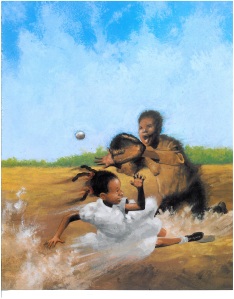
“In the early 1930s, career options were limited for African-American women. Most typically became teachers, nurses, maids and housewives. But Marcenia held on to her dream of playing baseball. Even when it was hard to get people to believe in her, she worked harder to prove that she could be a good baseball player. She made her dream come true, and her drive and determination inspired me to follow my heart, to work hard, and to bring my dreams to life.”
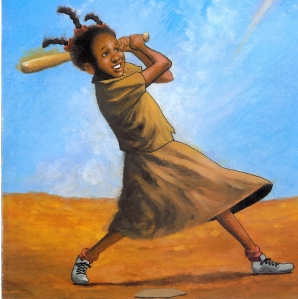
Further reading:
Black History Month: Why Remember Robert Smalls?
Filed under:
Holidays Tagged:
african american women,
African/African American Interest,
baseball,
black history month,
discrimination,
dreams and aspirations,
gender roles,
hard work,
Sports,
toni stone 

The Lost History of African-American Inventors. by Kareem Abdul-Jabber and Raymond Obstfeld, illustrated by Ben Boos & A. G. Ford. Candlewick, 2012. This is a fun, informative book introducing children to some of the major scientists and inventors of African American dissent. Told in story format, we join 13 year old twins Herbie and Ella when they move into a fixer-upper home in a suburban
by Carole Boston Weatherford. Great Brain Entertainment, 2013. (nook ebook). After I posted about the non-fiction book Africa for Kids; Exploring a Vibrant Continent last week, author Carol Boston Weatherford reached out to me on my G+ account to suggest I check out her latest ebook project, a poetry book called Africa. On her blog she says,
"Just in time for Black History Month. AFRICA, my
February is Black History Month and way back in 2011, I looked at a book about African American soldiers in World War II called
The Double V Campaign: African Americans and World War II by Michael L. Cooper. The Double V Campaign demanded that African Americans who were risking their lives fighting for freedom and democracy abroad should be given full civil rights at home - Victory at home AND abroad. Cooper's book is an interesting, well-researched book, but it doesn't tell the whole story of the Double Victory Campaign. The Double V campaign was also waged on the home front, and women played a very important part.
In her book,
Double Victory: How African American Women Broke Race and Gender Barriers to Help Win World War II, Cheryl Mullenbach brings together the lives and work of a number of strong, brave women in four areas: women who worked in the war industry, women who became political activists, women in the military, volunteers and of course, women in entertainment.
Here are only a few of the many stories covered in Mullenbach's book:
High school teacher Layle Lane was asked by A. Philip Randolph, a Civil Righs leader, to help organize a March on Washington in 1941 to end discrimination in employment, since most defense plants would not hire African Americans. The march never happened, but Lane was in on the talks with President Roosevelt that led to the issuance of Executive Order Number 8802, which meant if you discriminate, the Fair Employment Practices Committee can investigate you. It wasn't perfect, but it was a start.
Pauli Murray, a female law student, let students from Howard University in peaceful direct action sit-in at a restaurant that refused to serve African Americans. Three by three the students entered, sat and asked for service. When that was refused, they stayed seated and began to quietly study. Police couldn't arrest them because by not being served, they weren't breaking the law. The owner closed for the day, but when he reopened the next day, the students held a peaceful picket outside and after a few days of lost business, the Whites Only sign came down.
The women who joined the WAAC (Women's Army Auxiliary Corps) once it was opened to African Americans discovered the racism and segregation followed them into the military, just as it had followed men of color. Nevertheless, the women soldered on and succeeded. And eventually, Charity Adams even became the first African American woman officer in the WAACs and commanded the 6888th Central Postal Battalion (see
Mare's War by Tanita Davis for an interesting and accurate fictional account of one women's experience in the 6888th).
Star power carries a lot of weight and in WWII it was not different. When the Hollywood Victory Campaign was formed, actress Hattie McDaniel was asked to be in charge of "Negro talent" section. Hattie, who had won an Academy Award in 1940 for playing Mammy in Gone with the Wind, helped to organize black entertainers to perform in the segregated all black units of the armed forces. This work required the entertainers would need to meet frequently, usually at Hattie's house. But she lived in a restricted area, meaning no blacks allowed. So when the white homeowners filed a legal complaint, Hattie fought back and won.
Lena Horne, one of my favorite singers, was a favorite during the 1930s and 1940s and she was also part of the Hollywood Victory Campaign. Mullenbach tells about the time on a southern USO tour, Lena performed one night to a white only audience, and the next morning in the mess hall, she was to perform for the black soldiers. But in the front row were German POWs. She left the stage, stood in front of the black soldiers, back to the Germans and sang. She ended up quitting the USO tour over this, but continued entertaining soldiers throughout the war.
These are just a few of the many interesting women included in
Double Victory: How African American Women Broke Race and Gender Barriers to Help Win World War II. It is a well-researched, nicely presented book with lots of supporting photographs and detailed back matter. It is intelligently written, yet very accessible for young readers. The fact that she introduces us to ordinary women doing extraordinary things in wartime makes it all the more valuable. And while it is good to know that anyone can make a difference, not just famous people, it is also nice to read about the contributions of so many African American women, which are often overlooked.
Kathryn Atwood started a narrative about women and their courageous acts in WWII in her work
Women Heroes of World War II and Cheryl Mullenbach has extended that narrative to include African American women in
Double Victory: How African American Women Broke Race and Gender Barriers to Help Win World War II.
This book is recommended for readers age 12+
This book was an E-ARC from
Net Galley
For more on the Double Victory Campaign, see
Newspapers - The Pittsburgh Courier and
Fighting For Democracy - African Americans

By:
keilinh,
on 2/6/2013
Blog:
The Open Book
(
Login to Add to MyJacketFlap)
JacketFlap tags:
History,
diversity,
black history month,
Book giveaway,
Civil War,
guest blogger,
Janet Halfmann,
African/African American Interest,
Robert Smalls,
Add a tag
Everyone knows Frederick Douglass and Martin Luther King, Jr., but there are many other African Americans who have contributed to the rich fabric of our country but whose names have fallen through the cracks of history.
We’ve asked some of our authors who chose to write biographies of these talented leaders why we should remember them. We’ll feature their answers throughout Black History Month.
Today, Janet Halfmann shares why she wrote about Robert Smalls in Seven Miles to Freedom:

I was inspired to write about Robert Smalls because he played a very important part in the Civil War, but his role has received little recognition. He showed exceptional bravery, skill, and intelligence in stealing a gunboat from right under the eyes of the Confederates and sailing it through South Carolina’s Charleston Harbor to Union lines. I felt he was a great role model for anyone facing challenges. Also, I was riveted by his heart-thumping escape, and I thought kids would be, too. It was a great adventure story, just waiting to be told.
Robert Smalls and countless other African-Americans played important roles in helping to win the Civil War. In the past, not many of these stories have been included in history books. I feel it’s important for all Americans, and especially for African-American children, that the entire story be told. All children need role models that look like them.

Robert Smalls’ achievements deserve recognition for many reasons. During slavery, many people considered blacks incapable of ever measuring up to whites. Robert Smalls’ bravery and intelligence helped to prove this idea wrong. Robert Smalls was so popular after his escape that Union military officers in South Carolina sent him North to speak and raise money for the many newly freed men, women, and children streaming into Union camps. He also met with President Lincoln and helped to convince him to let African-Americans enlist in the Union army.
After Robert Smalls’ escape to freedom, he had a distinguished career as a civilian ship pilot for the Union. He was the first African-American named a captain of a United States ship. After the war, he helped write a new state constitution, which included his proposal for the creation of South Carolina’s first free system of public schools for all children. He went on to serve five terms in Congress, working for equal rights for all people. Robert Smalls was so popular in his hometown that he was called the “King of Beaufort County.”

Want to win a copy of Seven Miles to Freedom? Enter our Black History Month book giveaway.
Filed under:
guest blogger Tagged:
African/African American Interest,
black history month,
Book giveaway,
Civil War,
diversity,
History,
Janet Halfmann,
Robert Smalls 

by Michele Norris. Pantheon, 2010. (nook ebook) I am posting about a book for grown ups today.
Known as one of the hosts of NPR's All Things Considered, Michele Norris is a journalist who has also written for the Los Angeles Times, Chicago Tribune and Washington Post. She set out to write about her family after learning, almost by accident, that her father had been shot in the leg by police
 Black History Month 2013 commemorates two significant events in American History, the 150th anniversary of the 1863 Emancipation Proclamation, and the 50th Anniversary of the 1963 March on Washington, D.C. and Dr.Martin Luther King, Jr.’s I Have a Dream speech.
Black History Month 2013 commemorates two significant events in American History, the 150th anniversary of the 1863 Emancipation Proclamation, and the 50th Anniversary of the 1963 March on Washington, D.C. and Dr.Martin Luther King, Jr.’s I Have a Dream speech.
Black History Month began in 1926, largely through the efforts of Dr. Carter G. Woodson. February was selected because it is in February that we celebrate the birthdays of two great men, President Abraham Lincoln and Abolitionist Frederick Douglass. An interesting project is the Abraham Lincoln Historical Digitization Project by Northern Illinois University. Also, you might want to check out Stanford University’s The Martin Luther King, Jr. Research and Education Institute.
Books of interest compiled by Mary Schulte of the Kansas City Star:
- I, Too, Am America by Langston Hughes, illustrated by Bryan Collier
- Skit-Scat Raggedy Cat: Ella Fitzgerald by Roxane Orgill, illustrated by Sean Qualls
- Desmond and the Very Mean Word by Archbishop Desmond Tutu and Douglas Carlton Abrams, illustrated by A. G. Ford
- H.O.R.S.E.: A Game of Basketball and Imagination by Christopher Myers
- The Mighty Miss Malone by Christopher Paul Curtis
- Courage Has No Color, The True Story of the Triple Nickles, America’s First Black Paratroopers by Tanya Lee Stone
- I Have a Dream by Dr. Martin Luther King, Jr., paintings by Kadir Nelson
- A Splash of Red, the Life and Art of Horace Pippin by Jen Bryant
- Unspoken, A Story from the Underground Railroad by Henry Cole
- Hand in Hand: Ten Black Men Who Changed America by Andreas Davis Pinkney, illustrated by Brian Pinkney
Related Articles:
Graphic from Perris Valley Historical & Museum Association, Perris CA

 |
- "Frederick Douglass appealing to President Lincoln and his cabinet to enlist Negroes," mural by William Edouard Scott, at the Recorder of Deeds building, built in 1943.
- Highsmith, Carol M., 1946-, photographer
|
Last year, I reviewed a copy of Russell Freedman's,
Abraham Lincoln and Frederick Douglass: The Story Behind an American Friendship (Houghton Mifflin Harcourt, 2012). The story of their friendship and the "back story," was so interesting, that I thought it might make a good topic for a Black History Month program for younger children. I began searching for a way to communicate to a young library audience the connection between the history of African Americans and these two great men. In researching, I found that the founder of African American History Month (it was originally called Negro History Week), Dr. Carter G. Woodson, initiated this cultural celebration in 1926, and chose February because the birthdays of Abraham Lincoln and Frederick Douglass are both celebrated in February.
(1) I then discovered an earlier book,
Lincoln and Douglass: An American Friendship (Henry Holt, 2008), that recounts the friendship but targets a younger audience. Even better, it has a companion DVD. So, I planned a Lincoln and Douglass birthday celebration, featuring the Lincoln and Douglass picture book and an explanation of the founding of Black History Month. Perfect, right?
Well, not quite. In reading
Lincoln and Douglass: An American Friendship, I found several discrepancies. As it turns out, the timeline included in the picture book's back matter is correct, but some dates within the book's narrative are not. For example, Freedman's thoroughly researched book has the initial meeting of Lincoln and Douglass as a central theme. The picture book gets the date wrong. Though the picture book still has merit and will be useful to introduce Douglass and Lincoln to a young audience, I can also use it as a teaching moment. Always check to see that a book has been properly researched if you plan to use it as a representation of factual material.
Oddly, the same thing happened to me last year. I sketch out my programs many months in advance to satisfy printing and publicity deadlines. I fill the details in later. Last year, I offered a Black History Month program on
Follow the Drinking Gourd (Knopf, 1988). While investigating resources, I found that the story, while well-known and generally accepted, is more folk legend than truth.
(2) Again, the story is not without merit and I was again able to use it as a teaching moment. Besides the obvious lesson, we looked at ways in which to read the stars without a compass.
I understand narrative license. I understand that it's particularly useful in treatments of difficult topics for younger children. I also understand, however, that there is a concerted effort by our nation's leaders to raise a new generation of critical thinkers, and to achieve that end, the use of nonfiction books will rise dramatically. It is up to us as librarians, teachers, caregivers and parents to discern fact from fiction, even when the line between them may be indistinct. In doing so, we will help children to navigate a world where information is everywhere for the taking, but truth must be mined.
Today's
Nonfiction Monday roundup is at
Apples with Many Seeds.
And don't forget, February is a perfect time to head over to
The Brown Bookshelf; each day in February will feature a different artist in this annual celebration of Black History Month and children's literature.
(1) Library of Congress, "African American History Month"http://www.loc.gov/law/help/commemorative-observations/african-american.php (Douglass' actual birthdate is not known conclusively)(2) Follow the Drinking Gourdhttp://www.followthedrinkinggourd.org/
written by Nikki Grimes, illustrated by Bryan Collier. Simon & Schuster, 2008. We've been reading this book over and over in the past several weeks. The story begins with a mother and son watching Obama give a speech on TV during the 2008 campaign. The little boy in the story starts to ask why all the people are chanting and clapping as Obama stands before them giving an inspiring talk. His
View Next 25 Posts
 Wilma Unlimited: How Wilma Rudolph Became the World’s Fastest Woman by Kathleen Krull
Wilma Unlimited: How Wilma Rudolph Became the World’s Fastest Woman by Kathleen Krull Martin’s Big Words: The Life of Dr. Martin Luther King, Jr. by Doreen Rappaport and Bryan Collier
Martin’s Big Words: The Life of Dr. Martin Luther King, Jr. by Doreen Rappaport and Bryan Collier Bad News for Outlaws: The Remarkable Life of Bass Reeves, Deputy U. S. Marshal by Vaunda Micheaux Nelson
Bad News for Outlaws: The Remarkable Life of Bass Reeves, Deputy U. S. Marshal by Vaunda Micheaux Nelson Chains by Laurie Halse Anderson
Chains by Laurie Halse Anderson I Know Why The Caged Bird Sings by Maya Angelou
I Know Why The Caged Bird Sings by Maya Angelou


 Rip Van Winkle- Retold and illustrated by Will Moses, based on Washington Irving's book. Philomel Books a division of Penguin Putnam Books for young readers. New York 1999. This book is based on a classical folk tale about a man who goes into the woods and falls asleep waking up many years later to a new world. This classic tale is retold with a combination of wonderful illustrations and words. It is probably better suited for the older child because of complex words and storyline. This new version brings a wonderful story back to our modern world. The storyline and sophisticated crafted words make it more suited for an older child.
Rip Van Winkle- Retold and illustrated by Will Moses, based on Washington Irving's book. Philomel Books a division of Penguin Putnam Books for young readers. New York 1999. This book is based on a classical folk tale about a man who goes into the woods and falls asleep waking up many years later to a new world. This classic tale is retold with a combination of wonderful illustrations and words. It is probably better suited for the older child because of complex words and storyline. This new version brings a wonderful story back to our modern world. The storyline and sophisticated crafted words make it more suited for an older child. 


 The Little Engine that Could
The Little Engine that Could Under the Same Sun- Written by Sharon Robinson and Illustrated by AG Ford. Published by Scholastic Press, New York 2014. This is a great educational book about Tanzania a small country in Africa. One can vividly imagine the beautiful land of Africa with its lush scenery and many different animals. This book is very unique and the illustrations are amazing. The story is idle for a classroom setting.
Under the Same Sun- Written by Sharon Robinson and Illustrated by AG Ford. Published by Scholastic Press, New York 2014. This is a great educational book about Tanzania a small country in Africa. One can vividly imagine the beautiful land of Africa with its lush scenery and many different animals. This book is very unique and the illustrations are amazing. The story is idle for a classroom setting. 












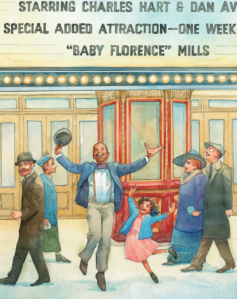












 Black History Month 2013
Black History Month 2013


Reblogged this on The Picture Book Pusher.